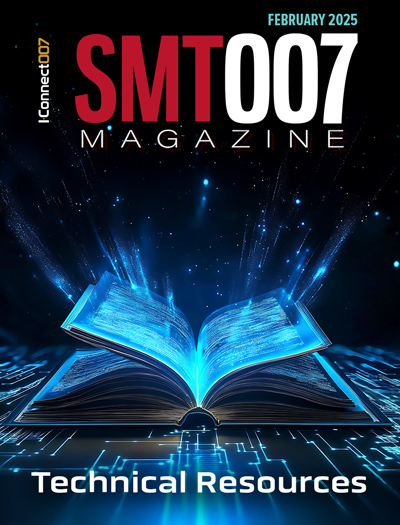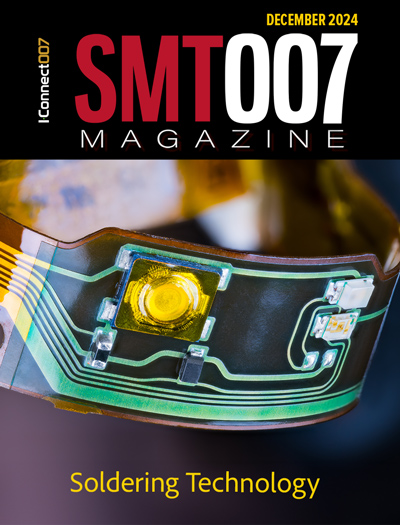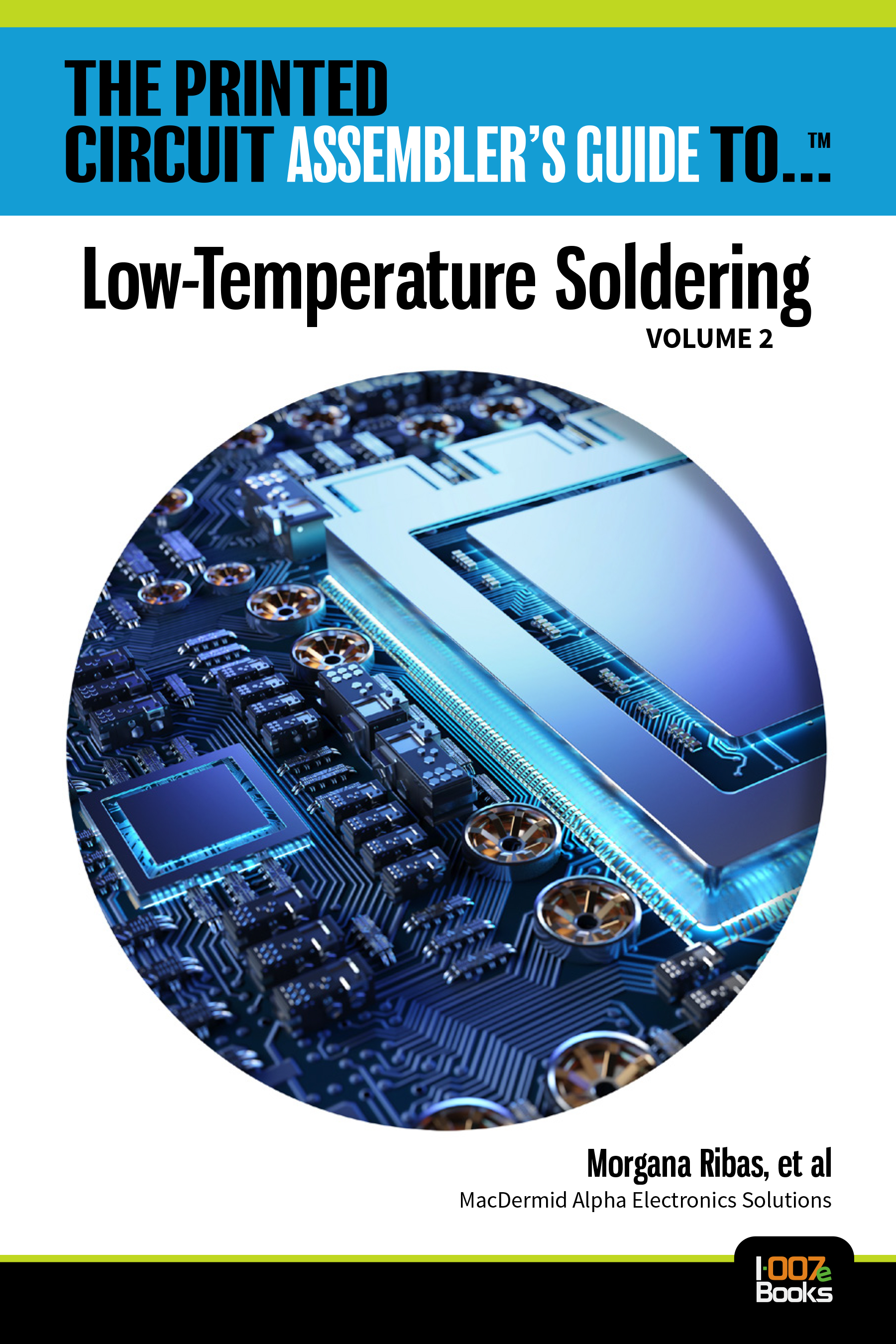-

- News
- Books
Featured Books
- smt007 Magazine
Latest Issues
Current Issue
Technical Resources
Key industry organizations–all with knowledge sharing as a part of their mission–share their technical repositories in this issue of SMT007 Magazine. Where can you find information critical to your work? Odds are, right here.

The Path Ahead
What are you paying the most attention to as we enter 2025? Find out what we learned when we asked that question. Join us as we explore five main themes in the new year.

Soldering Technologies
Soldering is the heartbeat of assembly, and new developments are taking place to match the rest of the innovation in electronics. There are tried-and-true technologies for soldering. But new challenges in packaging, materials, and sustainability may be putting this key step in flux.
- Articles
- Columns
Search Console
- Links
- Media kit
||| MENU - smt007 Magazine
Low-temperature Solder Paste Process Advantages
October 31, 2018 | Traian C. Cucu, Alpha Assembly Solutions, and Ioan Plotog and Mihai Branzei, Politechnica University of BucharestEstimated reading time: 7 minutes
Environmental issues are becoming increasingly important to organizations and individuals alike. The electronic assembly industry, like everyone else, is becoming more conscious about environmentally friendly processes and materials. This movement brings low-temperature processes and materials back into the spotlight because they can help with energy consumption and a reduced carbon footprint for assembly processes.
Tin/bismuth alloys have been used for a while in lead-free assembly processes in electronic assembly, one of the main concerns being the compatibility with the SAC (SnAgCu) spheres from ball grid array (BGA) and chip-scale package (CSP) components. Due to lower process temperatures, new chemistry platforms for solder paste need to be developed to fulfill both the assembly process requirements and the final assembly reliability. Solder joints are the result of the soldering process consisting of the temperature gradient action over the solder paste volume at the interface between pins and pads [1, 2]. Overall, the solder joint performance is described by the intermetallic formation at the interface of pad and solders volume as well as the pin and solder volume [3, 4]. The reduction of carbon footprint and the potential dollar savings add to the appeal of the low-temperature process [5].
The advantages of a low-temperature assembly process have long been a target for the assembly industry. Many attempts have been made by material suppliers to come up with an appealing chemistry platform that will allow the use of a low-temperature solder paste on an existing SMT line without major equipment changes (if any at all). Of importance, from the assembly process point of view, were the printability of the new platform and voiding performance. The printing performance of the proposed chemistry platform was evaluated using transfer efficiency (TE) for two aperture shapes—circle and square—as process indicators [6].
Practical
For the printing experiment, we used a DEK horizon printer with a four-mil stainless still stencil. We used a Keyence microscope for the visual inspection after printing and a Koh Young 8030 for the paste volume measurement after printing.
Four different printing experiments have been carried out to gather data for the following printing process indicators:
- Finest feature to print
- Print volume repeatability
- Response to pause
- Stencil life
This process indicators will provide a valuable indication of the rheological performances of the solder paste. After the reflow, we evaluated:
- Voiding
- Drop shock
- Thermal cycling
Transfer Efficiency
The stencil design used both square and round apertures 100–250 µ starting with an aspect ratio (AR) of 0.25 to force a failure and find the breaking point for the printing process. The finest feature to print was evaluated using the transfer efficiency process indicator. The combined transfer efficiency for the printing process for square and circle apertures is shown in Figure 1.
Figure 1: Combined transfer efficiency results for square and circle shaped apertures.
As pass/fail criteria, we used 50% transfer efficiency for the minimal acceptable value with the condition to have all values above that value, including any outliers that may occur.
Print Volume Repeatability
Print volume repeatability is the next process indicator used to characterize the paste performance. The print volume repeatability examines the printed solder paste volume repeatability for a given aperture at different printing speeds.
In Figures 2–4, we have the results for AR= of 0.6, 0.75, and 1, respectively. We used four printing speeds for this test with the printing parameters adjusted for optimum output for each speed.
Figure 2: Print volume repeatability for AR=0.60.
Figure 3: Print volume repeatability for AR=0.75.
Figure 4: Print volume repeatability for AR=1.
Response to Pause
The response to pause test evaluates the printed solder paste volumes variability for the first four consecutive prints, which provides valuable information about the capacity of a paste to recover after pause (i.e., the print strokes needed for the paste to recover after pause).
The response to pause test was carried out using the following process conditions:
- Out of jar
- After kneading
- One-hour pause without wipe
- One-hour pause with wipe
- Two-hour pause with wipe
Page 1 of 3
Suggested Items
SMTA UHDI Symposium 2025, Part 2: State of the Art
01/29/2025 | Marcy LaRont, I-Connect007A group of about 50 attended the second annual SMTA Ultra High Density Interconnect Symposium on Jan. 23, 2025. After a morning of technical presentations on challenges and solutions regarding UHDI technology, we gathered for a delicious Mexican buffet lunch and some networking before reconvening for an afternoon of more technical topics.
Connect the Dots: Designing for Reality—Surface Finish
01/29/2025 | Matt Stevenson -- Column: Connect the DotsIn the previous episode of I-Connect007’s On the Line with… podcast, we discussed the solder mask and legend process, one of the final steps in the PCB manufacturing process. The board is nearly complete. We just need to wrap up production by applying a surface finish to protect the copper from oxidation and facilitate soldering components onto the board.
AIM Solder Promotes Kelly Cardone to Vice President, Customer Experience
01/21/2025 | AIMAIM Solder, a global leader in solder assembly materials for the electronics industry, is thrilled to announce the promotion of Kelly Cardone to Vice President, Customer Experience. This promotion highlights AIM’s commitment to offering superior support and customer experience.
Indium to Showcase Durafuse Solder Technology at NEPCON Japan
01/21/2025 | Indium CorporationAs one of the leading materials providers in the electronics assembly industry, Indium Corporation® is looking forward to featuring its innovative Durafuse® solder technology at NEPCON Japan, taking place January 22-24, in Tokyo, Japan.
Peters Leverages Inkjet Technology to Optimize PCB Manufacturing
01/17/2025 | PetersPeters has put the second SUSS LP50 ‘Pixdro’ inkjet printer into operation. This machine enables the application of solder resist in digital additive technology by means of the inkjet process, thus providing Peters Research, in this relatively new segment, with more possibilities in research and process technology, in addition to the conventional coating processes (screen printing, curtain coating and spray coating).


